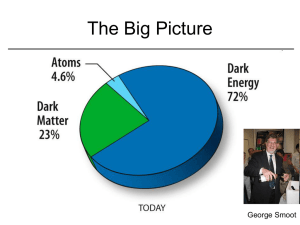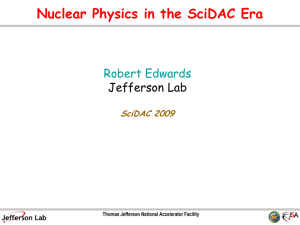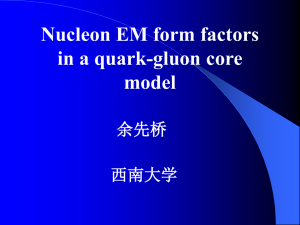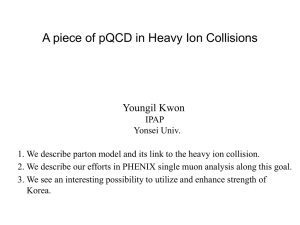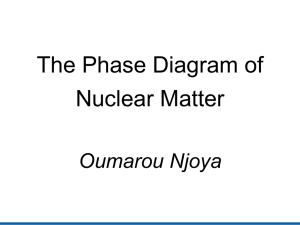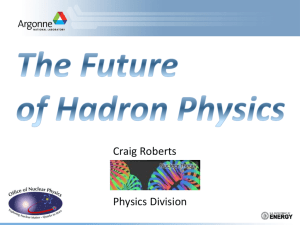1 page, Zhengguo
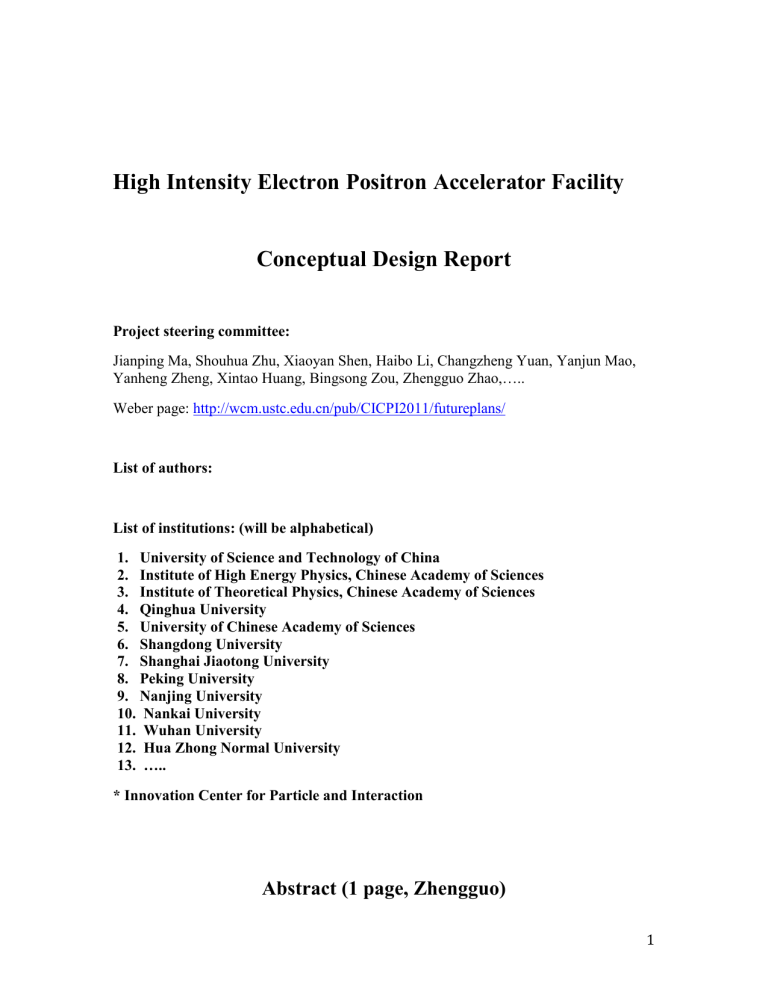
High Intensity Electron Positron Accelerator Facility
Conceptual Design Report
Project steering committee:
Jianping Ma, Shouhua Zhu, Xiaoyan Shen, Haibo Li, Changzheng Yuan, Yanjun Mao,
Yanheng Zheng, Xintao Huang, Bingsong Zou, Zhengguo Zhao,…..
Weber page: http://wcm.ustc.edu.cn/pub/CICPI2011/futureplans/
List of authors:
List of institutions: (will be alphabetical)
1.
University of Science and Technology of China
2.
Institute of High Energy Physics, Chinese Academy of Sciences
3.
Institute of Theoretical Physics, Chinese Academy of Sciences
4.
Qinghua University
5.
University of Chinese Academy of Sciences
6.
Shangdong University
7.
Shanghai Jiaotong University
8.
Peking University
9.
Nanjing University
10.
Nankai University
11.
Wuhan University
12.
Hua Zhong Normal University
13.
…..
* Innovation Center for Particle and Interaction
Abstract (1 page, Zhengguo)
1
Content
1 Physics program ( Jianping Ma, Shuhua Zhu for theoretical part, Changzheng and Haiping for simulation part )
1.1
Introduction
1.2
New physics beyond the Standard Model
1.2.1
1.2.2
CP violation of the tau lepton
1.2.3
Dark sector in the GeV region
1.2.4
Forbidden and rare decays
1.2.5
……
1.3
Physics with exotic hadrons and light hadron spectroscopy
1.3.1
Multi-quark states
1.3.2
Hybrids
1.3.3
Glueballs
1.3.4
…..
1.4
Hadron structure (form factor) ( Guangshun, Wenbiao )
1.4.1
Form factor of the nucleon
1.5
Charmonium
1.6
Physics with D meson
1.7
Charmed baryons
1.8
QCD study in the low energy region ( Guangshun, Weibiao
…)
1.9
Summary
2 Conceptual design of the detector ( Cheng Li, Jianbei )
2.1
General consideration and requirement ( Zhengguo )
2.2
Interaction region ( Dapeng Jin?)
2.3
Tracking detector ( Jianbei , Ouyan )
2.4
Electromagnetic calorimeter ( Zebo Tang, Junguang Lv )
2.5
Particle identification ( Ming Shao )
2.6
Muon detector ( Yongjie , Liang Han )
2.7
Superconducting solenoid ( Zhian Zhu ?)
2.8
Front end read out electronics ( Qi An, Ge Jin )
2.9
Trigger system ( Zhengan Liu, Shubin Liu)
2.10
Data acquisition system ( Kejun Zhu?
, Junfeng Yang )
2.11
Software ( Haiming, Yanwen, SDU?)
2.11.1
Detector simulation
2.11.2
Data reconstruction and calibration
2.12
Summary
3 Conceptual design of the accelerator ( Qing Qi, Lin Wang )
3.1
Introduction for the general consideration – an interdisciplinary mode
3.1.1
Layout of the accelerator
3.1.2
Injection region
3.1.3
Storage ring
3.1.4
Interaction region
3.2
Accelerator parameters
2
3.3
Vacuum system
3.4
Lattice
3.5
Beam-beam effect
3.6
Life time of the beam
3.7
Collective effect
3.8
Longitudinal polarization
3.9
Feedback system
3.10
Injection system
3.11
Summary
4 Beam injection system of the accelerator
4.1
The linarc
4.1.1.1
RF system of the linac
4.1.1.2
The beam focusing system
4.2
Beam injection
4.3
Polarized electron source
5 Cost estimation
5.1
Accelerator ( Qin Qing, Wang Lin )
5.2
Detector ( Li Cheng, Jianbei )
5.3
Civil engineering (? )
6 Consideration of site selection ( Zhengguo )
7 Summary ( Xiaoyan, Zhengguo, Guangda )
3
Q&A
Physics
The feature of tau charm energy region (2-6 GeV)
•
Rich of resonances: charmonium states, such as J/
,
(2S),
(3770) and particles are copiously produced at/around production threshold, providing a clear and unique laboratory to study the physics with charm quarks, and for the search of the existence of the new form of matter/hadron, including exotic hadrons, multi-quark states hybrids and glue balls.
•
Threshold characteristics: Pairs of
lepton, charmed mesons and charmed baryons,
(e.g.
+ , D
0
D
0
, D s
D s
,
c
c
) can be directly produced at their production thresholds, which leads to a better handling of backgrounds for the study of CP violation from the decays of tau and charmed mesons, as well as for the search for lepton number violating process from the tau decays.
•
Transition between smooth and resonances, perturbative and non-perturbative QCD.
It is also the energy region where exotic hadron, hybrid, glueballs are located.
Q: What are the significances of the physics for HIEPAF?
A: The most important physics are
1. Search for new forms of matter/hadron and study their properties
In the Standard Model (SM) picture, the fundamental building blocks of our universe are three families of quarks and leptons, plus force carrier particles that are responsible for transferring interactions among the particles. Our stable visible universe is consisted of the first family of quarks and leptons, of which over 99% of the mass is nucleon (proton and neutron) made of u and d quarks bounded by glue through strong interaction. The particles consisted of second and third quark families have very short life-time and decays immediately at their creation.
Is there any new forms of hadron/matter, such as glueballs, exotic mesons, hybrids and multi-quark, exist? This is one of the key science questions relating to the understanding of the visible universe in the subatomic level. The high luminosity e
+ e
- collider at taucharm energy sector is the best place, according to its features described previously, to tackle this problem.
Exotic hadron is made of quarks and possibly glues bounded by strong interaction and do not have the same quark content as ordinary hadrons. However, according to QCD, there is no fundamental reason why only 3-quark and quark-antiquark combinations should exist. E.g. the gluons, the force carrying particles of the strong interaction, can form bound states by themselves (glueballs) and with quarks (hybrid hadrons).
After several decades’ effort in search for the exotic hadron, XYZ particles, such as
X(3872), Y(4260) and Zc(3900) discovered respectively by Belle, Babar and BESIII
4
experiments at e
+ e
-
colliders of B factory and tau-charm factory are possible candidates of exotic hadrons. However, to reach conclusive evidence of an exotic hadron, an e
+ e
accelerator that is able to provide much higher statistical data and cover broad energy region is essential.
2. Measurement of the nucleon electromagnetic form factor
The nucleon (proton and neutron) electromagnetic form factors describe the spatial distributions of electric charge and current inside the nucleon and thus are intimately related to its internal structure; these form factors are among the most basic observables of the nucleon. Nucleons are the building blocks of almost all-ordinary matter in the universe. The challenge of understanding the nucleon's structure and dynamics has occupied a central place in particle physics.
QCD is the theory of the strong interaction, which is responsible for binding quarks through glues to form hadrons (baryons and mesons). The fundamental understanding of the nucleon form factors in terms of QCD is one of the outstanding problems in particle physics. Why do quarks forms colourless hadrons with only two stable configurations, proton and neutron? One important step towards answering this question is to characterize the internal structure of the nucleon. Besides the high energy electron scattering, the production of the nucleon/hadron pairs from the high energy e
+ e
-
collision around their production threshold provides one of the most powerful tools to investigate this structure.
3. Search for new physics
The discovery of the Higgs particle, first spin zero elementary particle, completes the list of the particles in the SM. However, the discovery of this new type of particle is not the end of the story of particle physics, but a beginning of a new era for exploring the new physics beyond the SM due to phenomena that cannot be explained within the SM framework, e.g. the SM does not explain gravity nor be able to supply any fundamental particles that are good dark matter candidates; attempts to explain dark energy in terms of vacuum energy of the SM lead to a mismatch of 120 orders of magnitude; Experimental evidence of neutrino oscillation have shown that neutrinos do have masses, which contradict the prediction from SM that neutrinos are massless; The SM predicts that matter and anti-matter should have been created in (almost) equal amounts if the initial conditions of the universe did not involve disproportionate matter relative to antimatter.
Yet, the anti-matter is missing in our observed universe and no mechanism sufficient to explain this asymmetry exists in the SM.
There are two frontiers of the search for new physics: the high-energy frontier (such as
LHC) to explore the new energy region for directly discovering the new particles and phenomenon, and the precision frontier (such as g-2 of the muonand
e
experiments, and Super B factory) to find out the discrepancies between the experimental data and the predictions of the SM. So far no evidence of new physics is found at the high-energy frontier for the p-p collision at the energy of 8 TeV (will be 14 TeV in the coming next a few years, and 100 TeV in probably 30 years). Since we don’t know at which energy scale the new physics will happen, it is crucial and complementary to search for new physics in the precision frontier.
5
With HIEPAF, one of the most important physics topics is to search for the lepton number violating process
General questions:
1. We have working on tau-charm physics for so many years, why do we want to continue?
2. What is the significance of the physics for HIEPAF, particularly in the SuperB era?
3. Can you reach the luminosity you proposed (1x10^35, but I am suggesting 100 times of BEPCII to be safe)
4. If IHEP is not going to do the project, are you able to make the project done?
5. How do you deal with the project of CEPC?
6. What key technologies you can gain from the projects?
7. Will you have enough participation internationally?
8. Where is the site is in your mind for HIEPAF?
9. What is the total estimated budget?
Prof. Yau's questions ???
Physics issues:
Q: Measurement of
at 10
-9
or 10
-10
, what's impact on new physics?
Q: What's the impact on new physics for CPV in tau if we can measure the T-odd asymmetry at 10
-4
? such as charged Higgs?
Q: The potential of XYZ at STCF? The possible new Charmonium spectrum on the understanding of QCD matter?
Q: Are there really charm physics at STCF ? in addition to measurement at Super-B?
Q: How large a contribution the measurement of R in lower energy region can contribute to the inter pretation of the g-2 of the muon, an important route of search for new physics at precision frontier.
6
